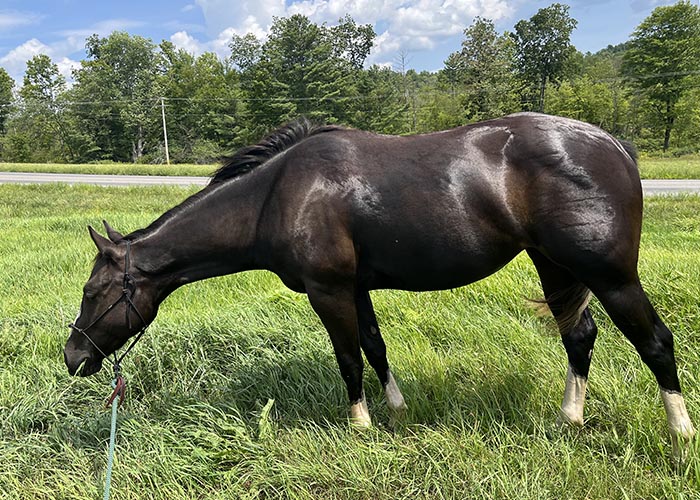
As an active equestrian, I am always looking for ways to improve my horses’ health and ensure they are as comfortable as possible. With this as a goal, I recently decided to start feeding my two-year-old Quarter Horse mare, Paisley, 100X Equine GutX and 100X Equine Osteo-Max in response to a few health issues. I monitored her closely for 30 days and received truly amazing results! I consider the benefits she receives from these to be practically a miracle. After my experience, I highly recommend both of these supplements.
One rainy evening, I found Paisley with a very swollen right hock joint. Luckily, she was not severely lame but she was very stiff due to the large amount of edema surrounding her joint. I had an emergency veterinarian come out to look at her, and they pulled blood to make sure she was not developing an infection in her joint. Fortunately, it came back negative. I decided to schedule x-rays to be taken by my primary vet, to make sure she did not have any bone injuries or abnormalities.
I was relieved when her x-rays came back clean: no osteochondrosis (OCD), no bone chips, no early onset arthritis, and no hairline fractures. However, my mare still had a swollen joint and she would cock her leg to rest it often. Paisley’s interesting case was a mystery.
Moving forward, Paisley was put on stall rest, with frequent cold hosing, leg wraps, and a prescription for phenylbutazone, more commonly referred to as Bute. After a few weeks on the Bute, she was developing loose manure. Her behavior was changing too. It was mentally draining seeing her in discomfort, change of behavior, and little improvement.
I decided to put Paisley on a probiotic supplement, hoping that it would help clear up her loose manure. I also switched her over to firocoxib (Equioxx) instead of the Bute, which would hopefully help her stomach. The loose manure resolved, but she was still not quite herself. Paisley was becoming spooky—I wasn’t sure if it was because of stall rest or maybe she was in pain. Her hock was slightly getting better but still swollen, and she continued to cock her leg to rest it. Due to the spookiness, I had my vet pull blood to test for Lyme disease, and that came back negative. I really wanted to find an answer; Paisley’s discomfort was becoming hard on me.
I decided to do some research on potential supplements to help her, and I came across 100X Equine products. The reviews and testimonials from happy users were remarkable! Each reviewer highly recommended 100X products. I appreciated the fact that the owners of the company have been involved in the equine industry for many years. They have helped with rehabbing and adopting horses, as well as competing in shows, winning several NRHA and AQHA championship titles. I personally found it very reassuring that there are knowledgeable equine professionals behind the product. I decided to try the products and began feeding Paisley the GutX and Osteo-Max.
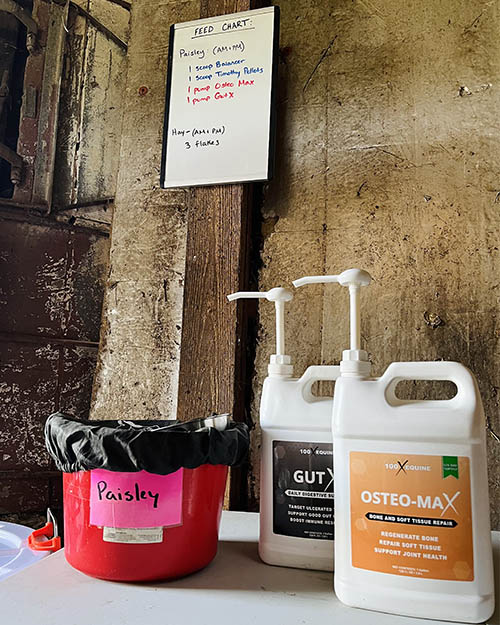
I chose GutX because I believed she was dealing with low-grade ulcers from taking the Bute. GutX is designed to help horses that are dealing with ulcers, fecal water syndrome, poor nutrient uptake, and poor immune system. Studies have shown that the active ingredients in GutX are effective in improving and healing stomach ulcers. The active ingredients can treat the hindgut due to the pH resilience of the supplement and provides support to the hindgut that properly allows the good bacteria to flourish. Within two weeks, Paisley had a quiet demeanor. She was no longer cranky and spooky. Her body condition looked better. She loved feeding time and licked her feed tub clean!
I also chose to start feeding Osteo-Max in hopes that it would support her hock health. Honestly, I was skeptical about it at first, however I was attracted to how it targeted bone and soft tissue repair and wanted to give it a try. Osteo-Max is known as the triple action supplement. It’s designed to support, repair, and maintain bone development, the fluid viscosity in joints, and strengthen soft tissues. Osteo-Max is said to not only replenish synovial fluid but also support the elasticity of soft tissue and increase bone strength. This supplement contains an amino acid blend to help build and repair cells. Additionally, Osteo-Max provides effective nutrition for horses dealing with bone abnormalities like OCD, Navicular, and Ringbone. This supplement truly delivered a miracle within 30 days! The edema in her hock subsided, and Paisley is galloping and bucking in her paddock like the young horse that she is again!
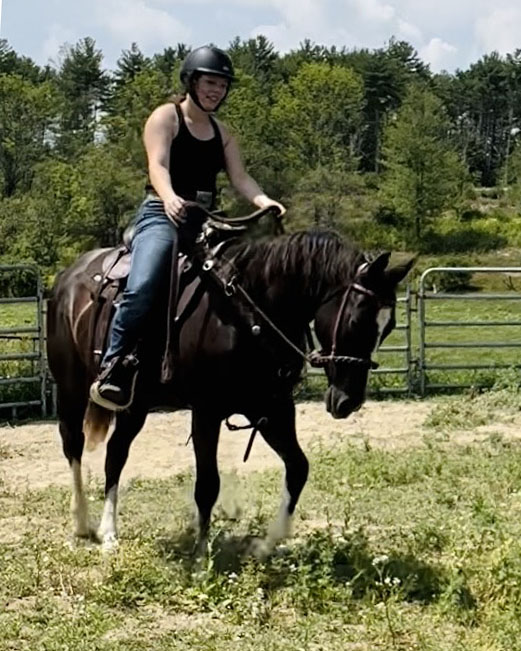
Thanks to the support that 100X products offered Paisley, her future is looking bright. I am excited to start her under saddle and am eager to see where her potential takes us. I plan to continue utilizing these powerful supplements throughout her training program to support her soundness and overall wellbeing. Thank you 100X Equine for these highly effective supplements that truly helped Paisley in such a positive way.
Shop the full line of 100X Equine products, including their supplements and equine soundness tools, such as the EquiMassager and the EquiLaser, here.
Averie Lowe is a former employee and frequent customer of The Cheshire Horse. Averie is a talented equestrian who has started many horses with a solid Western foundation. She can often be found competing at local rodeos or spending time with her young daughter.

I can’t find any information on giving osteo max to a laminitic horse, the ingredients seem safe but would love some input on this
Hi Lynn, this product is safe for horses that are laminitic. Although it will not cure anything, it is great for providing some relief from the symptoms!
Me too. I cannot find any information on whether osteo-max can help limonitic horses, It doesn’t really aid circulation, so I doubt it will help ease laminitis pain, but I’m just not sure.
I have a 22 yr old mustang with ring bone. He has had it for years and is a pasture puff. He is on equioxx. I know there’s no cure but do you think the Osteo-Max would help with the pain and make him more comfortable?
Thank you.
Hi Karen, yes! Plenty of customers use the Osteo-Max for ring bone, as it helps ease some of the symptoms to keep them more comfortable as well and helping with arthritis and bone development.
*** HELP NEEDED***Hi my horse has fractures her splint bone and has hairline fractures to the cannon bone and I’m looking for a supplement for bone regrowth and repair. Is this something that’d do this?
Hi Bev, we suggest that you seek counsel from your vet as your primary resource, although yes, OsteoMax can promote bone growth.
Do you have a link to the “studies” you referred to on GutX? Thank you.
According to the 100X Equine website:
The study by Slovis, N. 2016; concluded that horses given the “All Natural” polysaccharide blend of Hyaluronan & Beta Glucan showed that 90% had “Complete Resolution” or “Improvement” in ulceration. Improvements included morphological changes, behavior changes, weight gain and reduction of colic.
You say polysaccharide blend. I assume then GutX would not be safe for my PSSM horse.?
Hi Michelle,
Based on the current research and understanding of PSSM, GutX may not be the best choice for your horse. This is because GutX contains polysaccharides, specifically beta-glucans, which can act as prebiotics and increase the levels of certain bacteria in the gut. Unfortunately, in horses with PSSM, studies have shown that specific bacterial populations contribute to muscle glycogen storage issues. While the research is ongoing and not conclusive, it’s crucial to exercise caution when it comes to feeding prebiotics like GutX to horses with PSSM.
However, instead of ruling out GutX completely, we recommend discussing this with your veterinarian. They can assess your horse’s individual needs and condition, consider their specific type of PSSM, and provide the best guidance on whether or not GutX is a safe and appropriate supplement for your horse.
Remember, your veterinarian is the expert in your horse’s health and should always be consulted before making any significant changes to their diet or supplement regimen.
Will osteopathic max hurt a horse with cushings who is on Prascend?
Osteo Max is safe to feed to a horse with Cushings along with the Prascend!
thank you, this answers my question as well
will osteomax help with arthritis in the knee of a 1200 pound horse, and how long dose a gallon last. thanks
Yes, Osteo Max should provide some relief for a horse with arthritis since it will help with inflammation and joint pain associated with arthritis and will help to slow the progression.
I have a horse with navicular syndrome on one front foot, and as a result is now dealing with a twisted coffin bone on the other front foot. He is currently on Buteless which has been helpign with his symptoms, though we know there is no “cure”. Would Osteo-MAX be a substitute for Buteless or another supplement to go towards providing him with comfort?
Thanks!
Osteo Max should help provide some relief, since it will help with pain and inflammation associated with the navicular.
My 20 year old cutting horse has cushings. Due ti a really bad shoer he developed laminitis and he rotated his coffin bone. He could barely walk my vet suggested putting him down. I put him on osteo max and gut X along blood flow herbs he is now 100% sound and very happy
We’re so happy to hear that you found such success with this product!
Will this supplement help a 23yr old horse with mild arthritis? She is in moderate-heavy work, jumps 2’9 on average 3x a week, and is ridden 6x a week for an hour each time. She is stiff/’cracky’ quite a bit and has windpuffs + is prone to cellulitis.
Yes! The product works great for arthritis!
Hi
My 16 yr old horse has a stifle problem. Working with a vet, she is on gabapentin and Equiox. No significant improvement as yet (2months).
Would osteo max help in this situation?
Thanks in advance
Donna
Yes! Osteo will help with her joints and inflammation as well as boost collagen production. Just feed 2 hours apart from her medications and keep her at the two pumps a day.
Do you work for or are associated with 100x Company?
There’s nothing on the 100x website or label on the 100x OsteoMax that says you need to separate feeding Equioxx by 2 hours from OsteoMax but you have stated to do so here more than once. but not for Bute or banamine comments, just specifically for Equioxx.
Why 2 hours for Equioxx?
Hi Angie, this is the answer that we got from 100X:
The reason we recommend they are fed separate is because any NSAID will effect the efficacy of our products. It interferes with the absorption of the hyaluronic acid which is how we get the product into the bloodstream.
Hopefully that helps!
Hi Averie,
So glad to see you’re still responding to comments! How is your mare doing now that it’s been a few months? Are you still using both products and have you been able to discontinue the Equioxx?
Hi there! Thank you for reaching out. Yes, Paisley has been on Osteo Max (2 pumps twice daily) and GutX (1 pump twice daily). Paisley actually discontinued Equioxx the first week of the trial period to give me accurate results on 100X products. She has been thriving and 100% sound on 100X! Paisley will be starting her under saddle training come May 2023. I still plan to continue her on the 100X products to support her overall well-being, especially throughout her training. That being said, training can cause stress, soreness, and ph imbalance. So it’s very important to me that her stomach, hindgut, bones, and soft tissues are protected and supported throughout her training. Furthermore, I plan to increase her GutX to 2 pumps twice daily to prevent ulceration in her stomach and hind gut. These photos are from today:
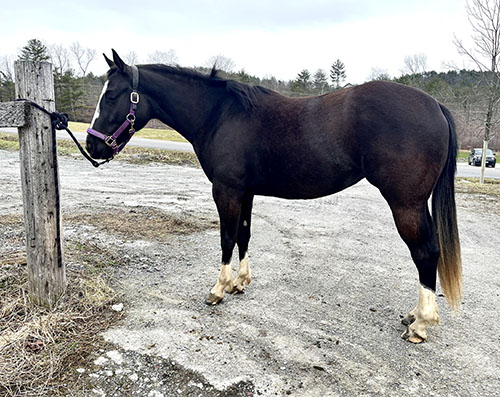
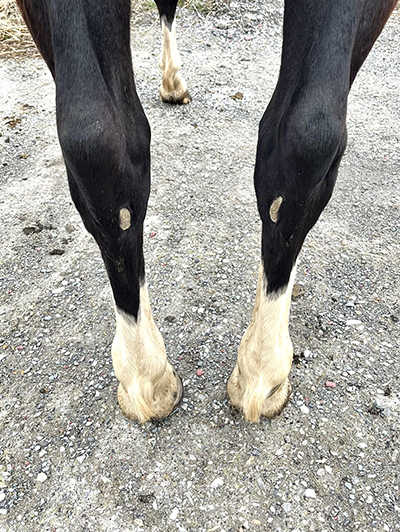
I’m wondering if there are any published clinical studies specifically with Osteo Max?
The manufacturer is working on a published study, but they take time. They do have many articles on their website supporting the research behind the products.
My 10 year old Quarter Horse Mare has a history of insulin resistance, Her IR numbers have been controlled with diet and exercise for the last 8 months and in September she had normal IR labs. I am considering purchasing your product Gut X as she does have symptoms associated with ulcers. I have not found a lot of information on feeding Gut X to an IR horse. Do you have information that may be helpful?
The product is not harmful to feed to a horse with IR and actually will help to regulate sugar in their body as well as help with any ulcerated tissue.
Can you explain how Gut X can help an IR horse? My horse is IR and would like to know the mechanism how it can improve IR.
Hi Elesa,
Unfortunately, there isn’t any scientific evidence available to definitively state that 100X Equine GutX directly helps horses with insulin resistance. While GutX is marketed as supporting gut health and immunity, its main focus is on preventing gastric ulcers and aiding nutrient absorption. These aspects haven’t been demonstrated to specifically address insulin resistance in horses.
However, some of GutX’s ingredients might indirectly contribute to improved insulin sensitivity:
– Mannan-oligosaccharides (MOS): These prebiotics can promote the growth of beneficial gut bacteria, potentially decreasing inflammation and improving insulin signaling.
– Apple cider vinegar: Studies suggest it may increase insulin sensitivity in humans, though research on horses is lacking.
– Biotin: This vitamin B plays a role in glucose metabolism and might theoretically assist with insulin action.
It’s important to note that these are isolated components, and GutX hasn’t been studied in the context of equine insulin resistance. Additionally, other factors influence insulin sensitivity, such as diet, exercise, and underlying health conditions. Therefore, relying solely on GutX to manage equine insulin resistance wouldn’t be recommended.
Instead, if you suspect your horse has insulin resistance, consulting a veterinarian is crucial. They can diagnose the condition, identify underlying causes, and develop a specific treatment plan tailored to your horse’s needs. Remember, seeking professional advice is always the best course of action when dealing with horse health concerns.
We are looking at these supplements for our horses and I wondered: did you pump both onto their feed at the same time? We feed once a day and I wondered if the two (Osteo Max and Gut X ) could be given at the same time or if you try to space them out….one in the morning, one in the evening.
Yes! They can be fed together. We recommend feeding 2 pumps a day for the first 30 days and then depending on your scenario, you may be able to back down to a single pump.
I have 3 qh mares ages 27, 29, and 31 years old. All 3 have cushings and arthritis. All 3 are on Prascend and Bute daily. Would these products help me be able to wean them off the Bute? The Bute seems to help with the pain, but I know it’s not good for them long term. Two of the three mares have bouts with runny manure.
Yes! Osteo Max should help with their arthritis, and many customers are able to discontinue Bute and Prascend once they start. The Gut X should help with runny stool. Depending on the severity of the arthritis, you may need to stay on the two pumps, but you can adjust up and down until you find a dose that fits well for them.
Why would you discontinue the Prascend? This is the only approved med to help with Cushings- it’s not for pain.
Osteo Max contains Silica which is a natural anti-inflammatory, so it should alleviate some pain. Some customers choose to stay on Prascend, but some are able to discontinue it. We always recommend consulting your vet before pulling them from their medications.
I’m concerned about your reply to Kristin Horton’s question. Are you confusing Prascend with something else? Prascend is for lowering ACTH levels in Cushings (PPID) horses. These horses have an abnormal pituitary. It’s not for pain. I don’t want someone to think they can discontinue this medication because they are using 100X Equine products. Please consult your vet if you have a cushings horse.
Good catch. As mentioned in the previous response, they should always consult their vet, but we did mis-speak. Osteo Max will help alleviate some of the pain associated with the laminitis or other symptoms that come with Cushings but will not change their metabolic function.
silica is not a treatment for Cushings and should not be considered a substitute fir Precend.
Hi Michele, that’s correct, as we had clarified, Osteo Max will help alleviate some of the pain associated with the laminitis or other symptoms that come with Cushings but will not change their metabolic function.
I have a 9 month old with a a swollen stifle. x ray and ultrasound are done. I don’t have a diagnosis yet but I am told he has abnormal bones changes that should not be on the back of his Petella.
Being so young with joint issues already is osteomax safe to use long term & what dose? He is on Equioxx rn 1/2 tan daily to help with pain and swelling
Yes! Osteo is safe to feed to all ages. It does need to be fed apart from the Equioxx but only 2 hours apart (so one in the morning and the other at night feeding). It should help with pain and inflammation as well as promote proper bone growth.
Amazing!….Always said there are so many great products to help horses….U can learn a lot by reading the ingredients and reviews and research. Did not know Hyaluronic acid was given in supplements….
What is the best way to “serve” the Osteo Max?
I have seen some discussion about using a syringe. Is this a preferred method for better absorption?
Hi Judy, both syringing it and feeding as a top dress is effective as long as your horse is eating all of their feed. Some people like to syringe it to guarantee they are getting the correct dose and the horse is eating all if it.
Is it ok to feed the Osteo Max along with the supplement Equinesaver by Figuerola Labs?
Yes! After reviewing the label online, it seems this is a vitamin/mineral supplement with added pre-/pro-biotics, and neither of those are in Osteo Max. They are supplements that will accomplish different goals.
I have a 24-year-old gelding. He was diagnosed with Navicular in his left hoof back in 2018. The bone looks a bit like swiss cheese and I have to be watchful that he gets enough HA to lubricate the Deep Digital Flexor Tendon. His supplements are Lubrisyn, MSM, and Maxum Crumbles. He was doing very well and completely sound until he damaged his tendon on a trail ride when he mis-stepped.
I’ve been researching the Osteo-Max, as it would be nice to combine the benefits of the HA (Lubrisyn) and the MSM (Animed) into one product, without sacrificing any effectiveness. And, of course, there would be the bonus of having the other helpful ingredients from the Osteo-Max, as well. 🙂
I’m also very interested in the claims of regeneration of bone to address the “swiss cheese” of his Navicular bone.
So, would I be able to switch to Osteo-Max without sacrificing any effectiveness of the full-on dosages of Lubrisyn and the 99.9% purity of the Animed MSM?
Also, would the Osteo-Max help with any regeneration of his Navicular bone?
Thank you in advance for your response!
Hi Sarah, wwitching to Osteo-Max could potentially streamline your gelding’s supplement regimen by combining HA and MSM benefits. Osteo-Max claims to enhance bone regeneration, addressing the “swiss cheese” appearance of his Navicular bone. However, its efficacy in comparison to the full dosages of Lubrisyn and the 99.9% pure AniMed MSM might vary. It’s crucial to consult your veterinarian specializing to determine the best course. They can assess your horse’s specific needs and suggest an optimal supplement plan, ensuring the highest effectiveness and overall well-being for your gelding.
I have a laminitic horse who is on cosquin msm and now on equioxx. He has a lump on his knee and diagnosed with arthritis. Can he be on the cosquin msm with the 100x equine? Also, will the 100x equine take the swelling down on his knee?
We are not veterinarians, but we can offer some general information. It’s essential for you to consult your veterinarian for personalized advice regarding your horse’s specific condition. Cosequin MSM is often used to support joint health in horses, while Equioxx is a non-steroidal anti-inflammatory drug (NSAID) commonly prescribed for pain relief, including arthritis.
Regarding combining Cosequin MSM with 100x Equine Products, your vet is the best person to advise on potential interactions. Additionally, while Equioxx can help manage pain and inflammation, its effect on the swelling of your horse’s knee might vary. Your vet can assess the lump’s cause and recommend the most suitable treatment plan, which may include medications, physical therapy, or other interventions. Always follow your vet’s guidance for your horse’s health and well-being
Your words have inspired me to take action. Thank you for sharing your wisdom!
If my horse doesn’t like the taste how do I get her to eat her grain? I’ve read some where that I could add water to her grain.
Hi Tim, if your horse dislikes a liquid supplement, try gradually introducing it to her grain. Mix the supplement with a small amount of water to dilute the taste. You can also soak the entire grain for a softer texture. Consider adding a sweet feed, molasses, or chopped fruits to mask the taste. Read our blog, Administering Oral Medications, for more ideas.
Observe your horse’s reactions and adjust the ratio accordingly. Maintain consistency and be patient in finding the right balance. If concerns persist, consult your veterinarian for personalized advice.
I have a 7 year old that has juvenile arthritis in her left hock. She has had hock injections that did not work and is currently on a 3 of 4 dose of Zycozan (first time using). she is also on a Vit D supplement. Would Osteo-Max help with Juvenile arthritis and should I discontinue Vit D?
Hi Catherine,
We are not veterinarians, but we can offer some general information. It’s crucial to consult with your veterinarian for advice tailored to your horse’s specific condition.
100X Equine Osteo-Max is designed to support joint health, containing ingredients such as glucosamine, chondroitin, and hyaluronic acid. These ingredients are often used to promote joint function and reduce inflammation.
Regarding discontinuing the Vitamin D supplement, it’s important to discuss this with your veterinarian. Vitamin D plays a vital role in calcium absorption and bone health, and the decision to discontinue or adjust supplements should be made based on your horse’s overall health and the veterinarian’s recommendations.
Keep in mind that managing juvenile arthritis in horses can be complex, and a comprehensive approach involving veterinary care, proper nutrition, and appropriate exercise is essential. Your veterinarian will be able to provide the most accurate guidance for your horse’s specific situation.
Which product would help my cinchy horse. Have checked saddle and pad fit.
He gets tight in the back and wants to buck but does not.
Walking and exercising him trying to relieve tightness in his back.
Do any of your products address this kind of issue?
Hi Alexis,
The best course of action would be to consult with a licensed veterinarian or equine bodyworker to determine the underlying cause of your horse’s discomfort. They will be able to perform a thorough examination and recommend the most appropriate treatment plan, which may or may not include supplements.
First things first, it’s fantastic that you’ve already ruled out saddle and pad fit. That’s an excellent starting point, and you’re absolutely right to prioritize those factors. Now, let’s explore some potential causes and solutions:
Digestive Distress: Tightness and back issues can sometimes be linked to gut imbalances. If your horse is feeling gassy, grumpy, or prone to colic, consider a gut-supporting supplement like 100X Equine GutX. This bad boy is packed with probiotics and prebiotics to keep his tummy happy and digestion smooth, which can often take the pressure off his back muscles.
Muscular Tension: Even with a perfect saddle, horses can hold tension in their muscles like us. That’s where massage and targeted stretching come in! We carry a great selection of massage tools like curry combs and back rollers, and our knowledgeable staff can show you some simple stretches to get those muscles relaxed and limber.
Chiropractic Care: Sometimes, a deeper misalignment might be at play. Consulting a reputable equine chiropractor can help ensure your horse’s spine is in tip-top shape and rule out any structural issues contributing to his discomfort.
Remember, finding the right solution may require a combination of approaches. The good news is, you’re already off to a great start by being observant and proactive. And hey, we’re always happy to chat and tailor a plan for your specific horse.